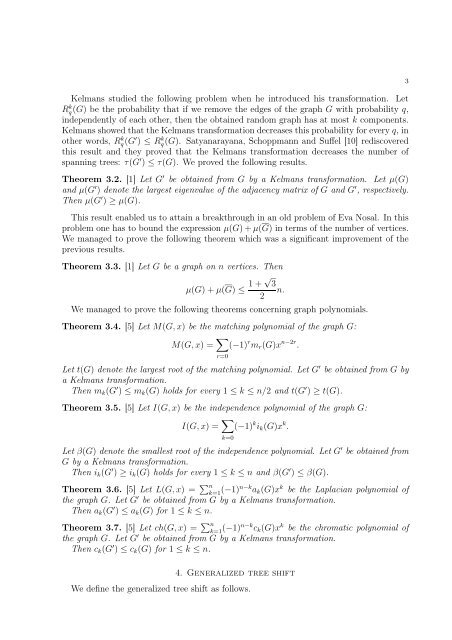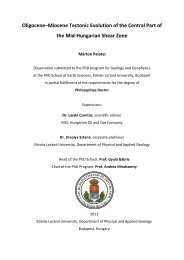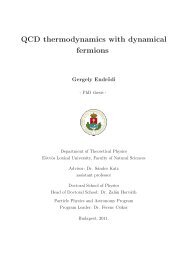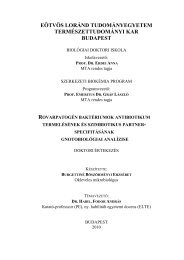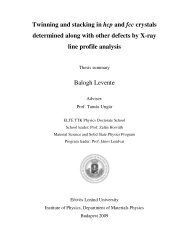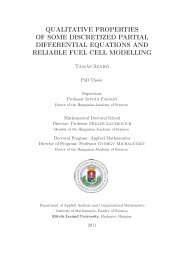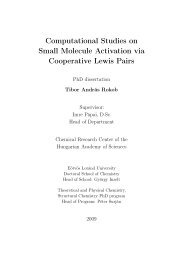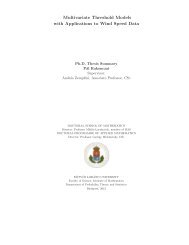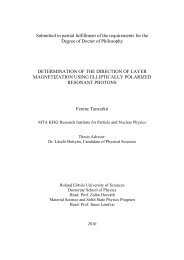Graph Polynomials and Graph Transformations in ... - ELTE TTK TEO
Graph Polynomials and Graph Transformations in ... - ELTE TTK TEO
Graph Polynomials and Graph Transformations in ... - ELTE TTK TEO
Create successful ePaper yourself
Turn your PDF publications into a flip-book with our unique Google optimized e-Paper software.
Kelmans studied the follow<strong>in</strong>g problem when he <strong>in</strong>troduced his transformation. LetR k q(G) be the probability that if we remove the edges of the graph G with probability q,<strong>in</strong>dependently of each other, then the obta<strong>in</strong>ed r<strong>and</strong>om graph has at most k components.Kelmans showed that the Kelmans transformation decreases this probability for every q, <strong>in</strong>other words, R k q(G ′ ) ≤ R k q(G). Satyanarayana, Schoppmann <strong>and</strong> Suffel [10] rediscoveredthis result <strong>and</strong> they proved that the Kelmans transformation decreases the number ofspann<strong>in</strong>g trees: τ(G ′ ) ≤ τ(G). We proved the follow<strong>in</strong>g results.Theorem 3.2. [1] Let G ′ be obta<strong>in</strong>ed from G by a Kelmans transformation. Let µ(G)<strong>and</strong> µ(G ′ ) denote the largest eigenvalue of the adjacency matrix of G <strong>and</strong> G ′ , respectively.Then µ(G ′ ) ≥ µ(G).This result enabled us to atta<strong>in</strong> a breakthrough <strong>in</strong> an old problem of Eva Nosal. In thisproblem one has to bound the expression µ(G) + µ(G) <strong>in</strong> terms of the number of vertices.We managed to prove the follow<strong>in</strong>g theorem which was a significant improvement of theprevious results.Theorem 3.3. [1] Let G be a graph on n vertices. Thenµ(G) + µ(G) ≤ 1 + √ 3n.2We managed to prove the follow<strong>in</strong>g theorems concern<strong>in</strong>g graph polynomials.Theorem 3.4. [5] Let M(G,x) be the match<strong>in</strong>g polynomial of the graph G:M(G,x) = ∑ r=0(−1) r m r (G)x n−2r .3Let t(G) denote the largest root of the match<strong>in</strong>g polynomial. Let G ′ be obta<strong>in</strong>ed from G bya Kelmans transformation.Then m k (G ′ ) ≤ m k (G) holds for every 1 ≤ k ≤ n/2 <strong>and</strong> t(G ′ ) ≥ t(G).Theorem 3.5. [5] Let I(G,x) be the <strong>in</strong>dependence polynomial of the graph G:I(G,x) = ∑ k=0(−1) k i k (G)x k .Let β(G) denote the smallest root of the <strong>in</strong>dependence polynomial. Let G ′ be obta<strong>in</strong>ed fromG by a Kelmans transformation.Then i k (G ′ ) ≥ i k (G) holds for every 1 ≤ k ≤ n <strong>and</strong> β(G ′ ) ≤ β(G).Theorem 3.6. [5] Let L(G,x) = ∑ nk=1 (−1)n−k a k (G)x k be the Laplacian polynomial ofthe graph G. Let G ′ be obta<strong>in</strong>ed from G by a Kelmans transformation.Then a k (G ′ ) ≤ a k (G) for 1 ≤ k ≤ n.Theorem 3.7. [5] Let ch(G,x) = ∑ nk=1 (−1)n−k c k (G)x k be the chromatic polynomial ofthe graph G. Let G ′ be obta<strong>in</strong>ed from G by a Kelmans transformation.Then c k (G ′ ) ≤ c k (G) for 1 ≤ k ≤ n.4. Generalized tree shiftWe def<strong>in</strong>e the generalized tree shift as follows.


